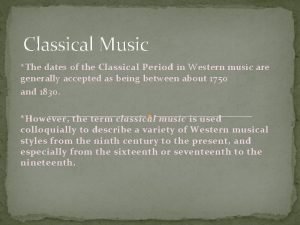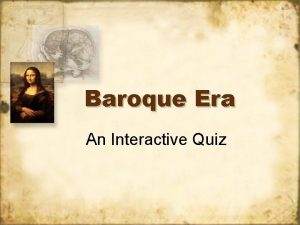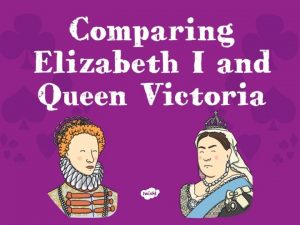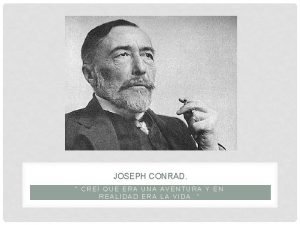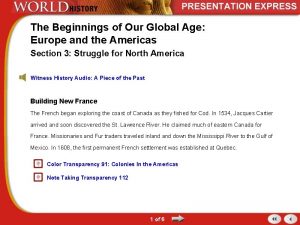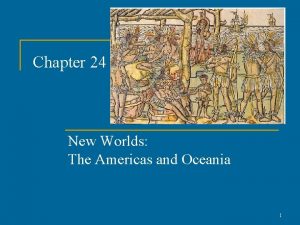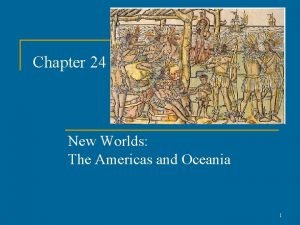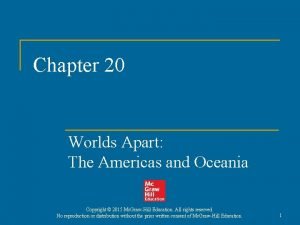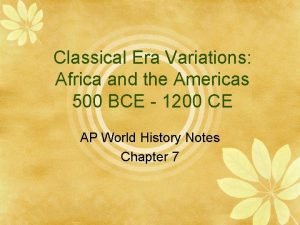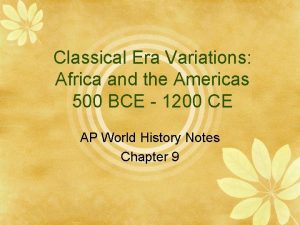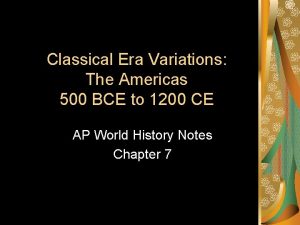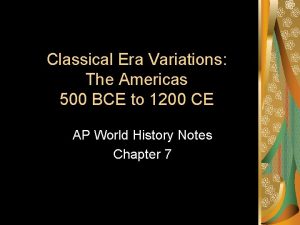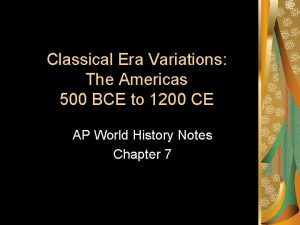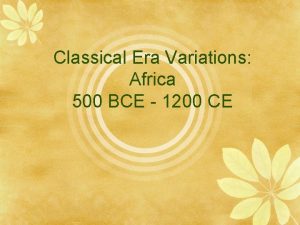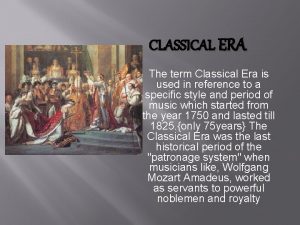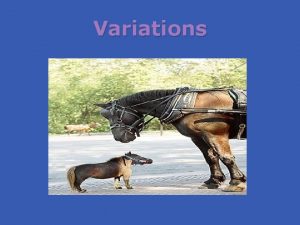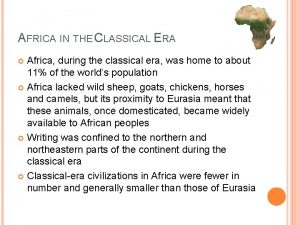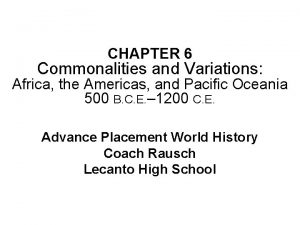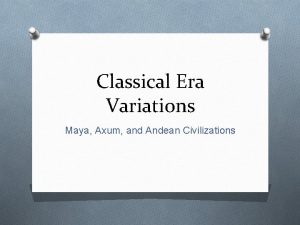Classical Era Variations Africa and The Americas Differences






















- Slides: 22

Classical Era Variations Africa and The Americas

Differences in Classical Civilizations �Important differences -the Americas lacked animals suitable for domestication -Africa imported previously domesticated sheep, goats, chickens, horses, camels -metallurgy was less developed in the Americas Writing -limited in the Americas to Mesoamerica; most highly developed among the Maya – used hieroglyphs -in Africa, was confined to north and northeast �Fewer and smaller classical civilizations in the Americas and Africa

Mayan Hieroglyphics

The African Northeast �Africa had no common cultural identity in the classical era. - great environmental variation within the continent - enormous size of the continent �Africa is the most tropical of world’s supercontinents -climate means poorer soils and less productive agriculture -more disease-carrying insects and parasites �Africa also shaped by interaction with nearby Eurasia and Arabia -North Africa as part of the Roman Empire -Arabia as source of the domesticated camel

Meroe – A continuation of the Nile Valley civilization �Nubian civilization was almost as old as Egyptian civilization -constant interaction -remained a distinct civilization �With decline of Egypt, Nubian civilization came to focus on Meroë -civilization there flourished 300 b. c. e. – 100 c. e. �Ruled by an all-powerful sacred monarch (usually female) -buried with human sacrifices �City of Meroë had craft specialization -ironworking was especially important

Meroe continued. . �Rural areas had combination of herding and farming -paid tribute to the ruler -farming was based on rainfall, not irrigation -so population was less concentrated on the Nile, less directly controlled by the capital �Major long-distance trade was the source of much of wealth and military power -had contact with the Mediterranean -also traded to east and west by means of camel caravans -less Egyptian influence than earlier times

Meroe Architecture

Decline of Meroe �Decline of Meroë after 100 c. e. -deforestation (too much wood used in iron industry) -conquest in 340 s c. e. by Axum -penetration of Christianity; Christian dominance for 1, 000 years -penetration of Islam after about 1300

Axum �Modern day Ethiopia �Productive agriculture, plow based farming �Center of trade, lots of state revenue from taxing merchants �King Ezana adopted Christianity around 300 c. e. �Expanded into the middle east, by modern day yemen �Both Meroe and Axum rivaled European civilizations and had direct contact with the Mediterranean

King Ezana

Stateless Societies �Along the Niger River– No evidence of states or citystates. �Little evidence of social inequality �Iron-smithing was the most popular profession �villages of cotton weavers, potters, praise-singers (griots) grew up around central towns �The middle Niger cities were stimulated by a network of West African commerce. �Large-scale states emerged in West Africa in the second millennium c. e.

South of the Equator: The World of Bantu Africa �over time, 400 distinct Bantu languages developed �Bantu-speaking peoples interacted with established societies �disease: Bantu brought new diseases to people with little immunity �gathering and hunting peoples were largely displaced, absorbed, eliminated

Bantu People

Bantu - Religion �religion placed less emphasis on a remote High God and more on ancestral or nature spirits -sacrifices (especially cattle) to access power of dead ancestors -power of charms was activated by proper rituals -widespread belief in witches -”diviners” could access world of the supernatural -no missionary work

Civilizations of Mesoamerica �There was a lack of interaction with other major cultures, including with other cultures in the Americas �Important civilizations developed in Mesoamerica and the Andes long before Aztec and Inca empires �Without large domesticated animals or ironworking

Maya �Development of advanced mathematical system �Elaborate calendars �Creation of most elaborate writing system in the Americas �Large amount of monumental architecture (temples, pyramids, palaces, public plazas)

Mayan Pyramid (ziggurat)

Mayan Politics �Large engineering projects. Aqueducts, terracing �City-states very fragmented (like Greece) �Rapid collapse in the century after a long-term drought began in 840 -extremely rapid population growth after 600 c. e. outstripped resources -political disunity and rivalry prevented a coordinated response to climatic catastrophe -warfare became more frequent

Teotihuacán: America’s Greatest City �city was begun ca. 150 b. c. e. �by 550 c. e. , population was 100, 000– 200, 000 �much about Teotihuacán is unknown �city was centrally planned on a gridlike pattern �specialized artisans �Aztecs named the place Teotihuacán: “city of the gods”

Moche: A Regional Andean Civilization �Agriculture based on complex irrigation system �Rule by warrior-priests �Rituals mediated between humans and gods �Use of hallucinogenic drugs �Human sacrifice

North America in the Classical Era Hopewell “Mound Builders” �Gathering and hunting peoples still populated much of Americas �Agriculture began to supplement hunting and gathering �Large burial mounds

North America - Iroquois � 5 Iroquois tribes from New York �Lived in “longhouses” �Formed Iroquois Confederacy (democracy)
 State building in the americas and africa
State building in the americas and africa Classical conditioning vs operant conditioning
Classical conditioning vs operant conditioning Classical conditioning vs operant
Classical conditioning vs operant Classical conditioning vs operant conditioning
Classical conditioning vs operant conditioning Computer organization & architecture: themes and variations
Computer organization & architecture: themes and variations Transistor biasing and stabilization techniques
Transistor biasing and stabilization techniques Music timeline
Music timeline Romantic era ballet characteristics
Romantic era ballet characteristics Classical music period dates
Classical music period dates Era opera
Era opera Musical periods
Musical periods Late classical era
Late classical era Post classical era timeline
Post classical era timeline Classical theories of management
Classical theories of management Baroque music quiz
Baroque music quiz Elizabethan and victorian era
Elizabethan and victorian era Creí que era una aventura y en realidad era la vida
Creí que era una aventura y en realidad era la vida Poema sobre as estrelas
Poema sobre as estrelas The beginnings of our global age europe and the americas
The beginnings of our global age europe and the americas Chapter 24 new worlds the americas and oceania
Chapter 24 new worlds the americas and oceania Chapter 24 new worlds the americas and oceania
Chapter 24 new worlds the americas and oceania New worlds the americas and oceania
New worlds the americas and oceania Ap world history chapter 20 the americas and oceania
Ap world history chapter 20 the americas and oceania








